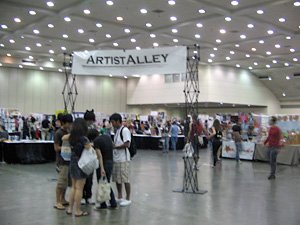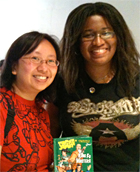You are currently browsing the monthly archive for July 2009.
 The past few Wednesday posts have been about zombies, creators, and conventions. But before editors get as far as strolling through artists alley looking for talent, we have to decide what to publish. For most imprints, like Graphic Universe, that means figuring out how to balance different types of books, while always thinking about the particular voice of the imprint and Lerner. Myths & legends, interactive fiction, and ongoing adventure epics have all been in the GU mix. The Manga Math Mysteries series is something a little different, starring a recurring cast of kids who apply math concepts to real-world situations to solve a mystery. As the title proclaims, the art is manga style—the style flourishing here in the U.S. as manga-ka (artists) develop their voices and balance the various traditions of manga from Japan with the sensibilities of artists coming into their own in the 21st century.
The past few Wednesday posts have been about zombies, creators, and conventions. But before editors get as far as strolling through artists alley looking for talent, we have to decide what to publish. For most imprints, like Graphic Universe, that means figuring out how to balance different types of books, while always thinking about the particular voice of the imprint and Lerner. Myths & legends, interactive fiction, and ongoing adventure epics have all been in the GU mix. The Manga Math Mysteries series is something a little different, starring a recurring cast of kids who apply math concepts to real-world situations to solve a mystery. As the title proclaims, the art is manga style—the style flourishing here in the U.S. as manga-ka (artists) develop their voices and balance the various traditions of manga from Japan with the sensibilities of artists coming into their own in the 21st century.
 I was amused to find articles online that purport to explain exactly how publishers acquire books and the super-secret foolproof way for authors to survive the process (I won’t link to them—such knowledge must be earned through one’s own epic Google-quest). Truth be told, every publishing house has its own method: some casual; others bound up in forms, focus groups, and number-crunching; some that allow for flashes of editorial instinct (“I see teenagers lined up for days to get the next volume! Also, bet on Brobdingnag’s Revenge in the third race.”).
I was amused to find articles online that purport to explain exactly how publishers acquire books and the super-secret foolproof way for authors to survive the process (I won’t link to them—such knowledge must be earned through one’s own epic Google-quest). Truth be told, every publishing house has its own method: some casual; others bound up in forms, focus groups, and number-crunching; some that allow for flashes of editorial instinct (“I see teenagers lined up for days to get the next volume! Also, bet on Brobdingnag’s Revenge in the third race.”).
But I do like the articles that describe the editor as the author’s advocate—after all, we wouldn’t bother showing a new project to others in the company unless we thought it had strong legs. I find that acquiring can feel like being a public defender at an arraignment in a fast-paced court. Think of the stereotypical Law & Order episode at about 40 minutes in. There are further metaphors I could extend about bail and the books being released on their own recognizance, but I’ll leave you to develop those on your own.
Hello! Starting in July I came on board as an intern in Graphic Universe’s office in New York City. A few years ago I began writing professional convention coverage for Publishers Weekly Comics Week (online) and Otaku USA Magazine’s website. I’m also a manga and anime reviewer for both. You can read my convention reports on their respective websites.
Almost every weekend in North America there is at least one convention devoted to Japanese animation (anime) and comics (manga). Check AnimeCons.com for the yearly schedule. Last weekend, I went to Otakon, in Baltimore, Maryland, the second largest anime convention in the U.S.
When I told Carol about Otakon, she said, “Oh, good! You can look for artists in the Artist Alley for Graphic Universe.” I was sent off with a pocketful of petty cash.

Otakon Artist Alley
Carol had only one request for me: “Just make sure they’ve done sequential art before.” Some artists are great at drawing pin-ups but they have never tried to do comics. It is a different skill, and artists must show they can draw a whole story, not just terrific single images.
There were artists who tried to emulate manga, and those who went more for a superhero American comic look. Conventions often catch the crossover audience between the two comic worlds. Some attendees at Otakon dressed as Watchmen characters, just like how at San Diego Comic Con some attendees dress as Naruto characters.
Otakon attendees are a young crowd, from about age 13 to 30. Because Otakon does not sell one-day admissions and only expensive 3-day passes, the crowd skews older than smaller, more suburban conventions like MangaNext, where the average attendee is around 17. By contrast, the average San Diego Comic Con attendee is 25-35—unless they’re spending all their time in the anime rooms, in which case, they are much younger and more female.
Any Artist Alley is a good place to look for the next great undiscovered talent. You just have to keep your eyes open.

 Last Wednesday I mentioned our new title
Last Wednesday I mentioned our new title  (left: Evonne Tsang and Alitha E. Martinez show off a copy of their book. I took 97 photos with the shiny new iPhone. Most of them are out of focus. One of them is of my foot. And out of focus.)
(left: Evonne Tsang and Alitha E. Martinez show off a copy of their book. I took 97 photos with the shiny new iPhone. Most of them are out of focus. One of them is of my foot. And out of focus.) (right: Evonne Tsang and stalwart GU editorial intern/Publishers Weekly manga reviewer Erin Finnegan. Trivia:
(right: Evonne Tsang and stalwart GU editorial intern/Publishers Weekly manga reviewer Erin Finnegan. Trivia: